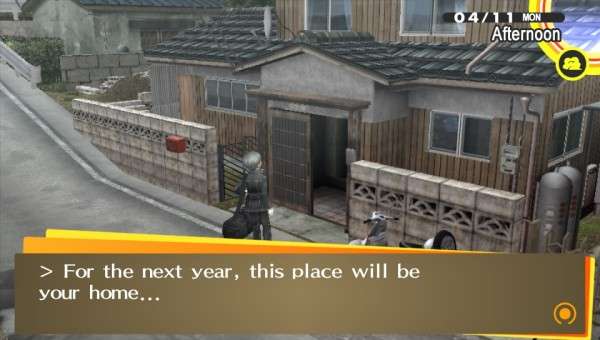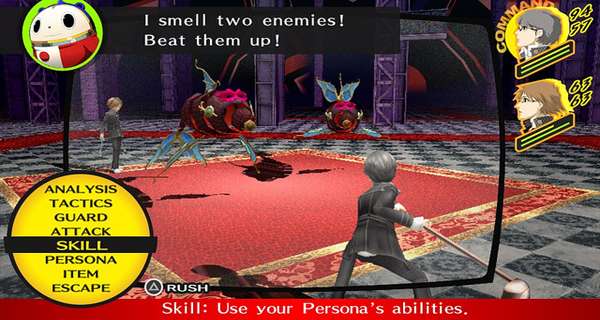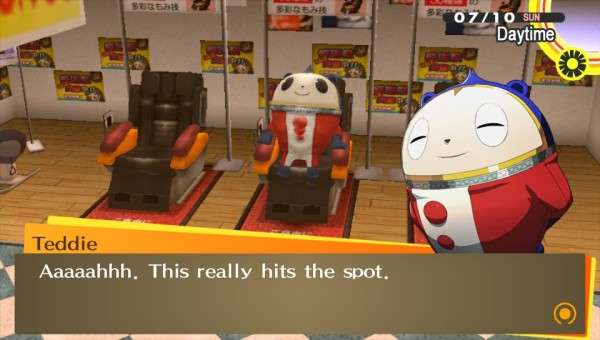
Persona 4 Golden Vita Review
When it comes to naming the greatest games, I am not at all afraid to say that the PlayStation 2 release of Persona 4 ended up as not only one of the best RPGs I had ever played, but one of my favourite games of all time. Persona 4 was the ultimate swan song for the PlayStation 2 – which had built itself up to be quite a system for fans of Japanese RPGs. Persona 4 came so late into the system’s life (we’re talking early 2009 if you lived in the UK), and yet it kicked so much butt, showing the current generation of consoles how to develop a fantastic showpiece for the genre. This generation never quite hit the heights of some of the wonders that appeared on the PS2, but now the Vita has been blessed, because Atlus has decided to grace the beautiful hardware with one of its most critically acclaimed classics, and it also comes with a bunch of additions to make this revised entry the best version of the game. Atlus have so rightly named it Persona 4: Golden.
I originally reviewed the PS2 version of Persona 4 on its release, and I totally recommend that you check out that huge review to understand most of the core features about the game, as that part of Persona 4: Golden still remains the same. The story begins in the middle of April, where you take control of the main character, who has just transferred from Tokyo to the countryside town of Inaba and is staying with his Uncle for the duration of the year. It’s not long until bizarre happenings begin and you are pulled into the strange story of the Midnight Channel. You see, Persona 4: Golden’s story is quite different from your typical RPGs. This is a murder mystery at heart, it’s about people disappearing and reappearing on the Midnight Channel, a TV program that shows the hidden personalities of people who are about to be murdered, and it ends up being the main character’s role to figure how this is happening and stop it with his newly acquired power of Personas.

The story is truly unique for the genre, but what makes it even more distant from typical JRPGs is the game’s blend of two different styles of gameplay. First, you have dungeon exploring, which features random generated dungeons so you get a different layout each time you enter. Then there is the other half, the daily activates of the hero and the Social Links he interacts with, which allows the hero to make new friends and learn about these additional characters, both playable and NPCs, and how they grow to deal with their own social problems in life. There is a reason why you want to do all this, as increasing your Social Links with these characters offers rewards in a multitude of ways. This could be learning new moves and abilities for your comrades in battle or being able to create Personas with the fusion system and have them automatically gain more levels. Some of the more powerful Personas require you to max out Social Links to be able to gain them.
Time management is an important mechanic in Persona 4: Golden, as entering dungeons to train or save people, gaining Social Link levels, and even studying for exams all take time away from you. Missing people have to be saved by a certain date; if not, it’s game over. During the period you spend with the game, you move from April 2011 till March 2012, with each day just as important as your last. You have to try manage your life as a student, act as a friendly “big bro” and also as the unknown saviour of Inaba. It’s such an absorbing and emotional ride to meet all these people, especially the characters who suffer from problems that hit on a personal level, be it because of an experience in your own life or of people that you know have gone through the same rough patch. It handles this content with an adult attitude, and never feels tacky or coming off childish.

If you have read the PS2 review, then we have established that Persona 4 is one hell of a game, so what does this golden port to the Vita bring to make the game even better? First up is the inclusion of two new Social Links. One of the new characters is Marie, a character who sits in the Velvet Room alongside Margaret and Igor. The other Social Link is Adachi (this will ring bells with fans), a humble, if somewhat dense cop, who plays side-kick to the main character’s Uncle. If you manage to accomplish these links, you gain access to additional scenes and a new dungeon. On the topic of scenes, there are quite a few additions added to the story. Most of them are fillers and don’t add much to the overall plot, but they’re entertaining and often funny enough that they make a nice inclusion for the title. They never seem out of place and blend perfectly with the existing content. There is 50% more voiced over scenes, making the already high volume of exceptional quality voice acting even more. It must be noted that the new voices for Chie and Teddie, which were used in the release of Persona 4: Arena, are present in Persona 4: Golden. This is because the original actors had conflicting schedules and could not return to record the new dialogue in the game.
There is easily enough new content here that Persona 4 fans should consider returning to the game to check it all out. Newcomers are also given a nice introduction, as the inclusion of very easy settings allows them to simply enjoy the story, while veterans can take the step up and jump head first into the challenging very hard difficulty. Rounding off the package are new Personas, new music, new areas to visit, the ability to walk around town at night (helpful for building them Social Links), changeable costumes and a new epilogue for the true ending, and plenty of other bits and bats that are aimed solely at fans (live concert recordings). One of the biggest changes to the core mechanics is the inclusion of being able to pick what skills you want to inherit from Personas when you fuse Personas together. Originally, if you were fixated on trying to make sure one specific skill would carry across to the new fused Persona, you would have to keep cancelling and picking the Personas that needed fusing until it randomly popped up, which could have taken up to 10 minutes. This is such a time saver and a great design decision to put into the game.

The battle system has also been tweaked so that fights now include team attacks that deal out extra damage. Changes have happened to the Shuffle Time mechanic too. The cards face you, and you pick the one you want. Cards will often come with modifiers that will reduce gold, items or experience in exchange for switching cards with new ones or giving you the chance to pick multiple cards, making the mini-game feel more like a game show rather than the skill based Shuffle Time in the original Persona 4. Like I said already, there is so much stuff added to Persona 4: Golden that it feels like an extension and should not be looked at as a port – it’s so much more than that.
One thing that I feel seems a little pointless are some of the online features. The part where you can access other gamers’ choices during the day is really handy and will help newcomers with ideas on what they should be doing when they see that on a certain day most players decided to speak to this character or picked to visit the dungeon. I love seeing statistics such as these. The S.O.S mechanic allows you to call for help from other players who are connected to the PlayStation Network and are playing Persona 4: Golden. It’s not as handy as it seems, because you click on the S.O.S icon and then either send help when a message pops up or gain help if someone did the same to you before your next encounter. The problem is that this isn’t worth the hassle; you gain minimal health and magic back that the act of enabling it after every battle is too much of a chore.

Visuals on the Vita screen are crisp and full of colour. The graphics are enhanced from the PlayStation 2 version with higher resolution art, better models, and textures and backgrounds getting a reworking. The music is still as amazing and catchy as ever, and I advise everyone to use headphones and be enraptured by one of gaming’s most charming and memorable soundtracks. The only downfall for super hardcore fans is that there is no Japanese option. This didn’t matter to me because the English cast is so incredibly strong, and they all do a fantastic job portraying the characters they voice.
I said in my original review that Persona 4 is a title that should be played by every single man, woman and child who has any interest in the story or has even the tiniest interest in the RPG genre. That’s even more relevant now, so if you haven’t played Persona 4 and you own a Vita – hell go buy a Vita and play it. It’s worth it as it is the best game on the system – Persona 4: Golden is a must play, even for fans who have already previously completed the game. They should play it again, because the return trip to Inaba is a near perfect enhancement full of new things to discover and improvments on an already amazing game. It’s never been as easy for me to award a game the highest score as it has with Persona 4: Golden – this is a gaming classic.
